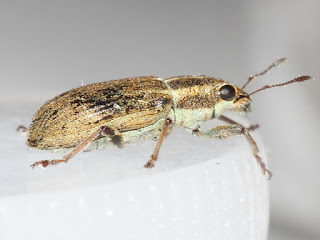Rarely is it this late before I see a butterfly, but this year it wasn't until Friday that I saw my first identified butterflies (a couple of brief glimpses previously) - Small Tortoiseshells in 3 locations and 2 Brimstones at Hockwold Fen. Hockwold Fen was also the site of my only beetle of the day, a new species for me, albeit apparently a very common one - Pea-leaf Weevil Sitona lineatus.
Pea-leaf Weevil Sitona lineatus, Hockwold Fen, 25th March
Earlier in the day at Lynford I found several slugs descending tree trunks. I'm in the process of putting together a pan-list but haven't got to slugs yet, and so not made much attempt to identify many of them so far. But these looked a bit different to the slugs I'm used to seeing so I decided to look them up. Not 100% sure but I think they're Chestnut Slugs Deroceras invadens (please correct me if I'm wrong).
Chestnut Slugs Deroceras invadens (I think), Hockwold Fen, 25th March
When it comes to pan-listing plants I'm not sure how you can tell garden escapes from naturalised plants - I gather the latter are considered 'countable' while the former aren't. I suspect if I ever want to take my pan-list seriously (which is unlikely) I will have to delete quite a few escapes from it. Pretty sure half the flowers along the seawall at Burnham Overy are dodgy! Spanish Bluebells and Grape Hyacinths for example. Even assuming I've identified it correctly I doubt if I would be allowed to count this Glory of the Snow at a fly-tipping site...
Glory of the Snow (I think), near Cranwich Heath, 25th March
The next one was so abundant it must either be wild or naturalised, but for the life of me I couldn't find it in my books. I was sure I've seen it before, and thought I'd even known what it was called once upon a time. But I couldn't remember and asked here for help. Big thanks to James again for coming to the rescue - it's the naturalised Oregon Grape (and I don't think I had ever known it before as it turns out).
Oregon Grape, Cranwich Heath, 25th March - thanks James for the ID
I'd hoped to find some moths or other interesting inverts at Cranwich Heath but drew a complete blank. Walked all over and failed to find a single moth, beetle or bug. I thought the semi-warm sunny afternoon might be good, but either it wasn't warm enough or it waas just too early in the season. Or I wasn't looking hard enough. At least this Fox was big and easy enough for me to see and identify it...
Red Fox, Cranwich Heath, 25th March
Cranwich Camp was hard work too. I did find an intriguing woodlouse - on a rotting stump and spending most of its time down holes in the wood. There are reasonably good references freely available online for woodlouse ID so I imagined I'd be able to put a name to it, but didn't succeed. Once again James came to the rescue, keying it out as Common Rough Woodlouse Porcellio scaber.
Common Rough Woodlouse Porcelio scaber, Cranwich Camp, 25th March - thanks to James for the ID
One blossoming Sallow was attended by a number of bees, two of which I photographed. I have vague recollections of identifiying Buff-tailed Bumble Bee in my youth but when I was going through my bee photos recently I couldn't find any of this species, so didn't add it to my pan-list. I can now though, as I think this is a Buff-tailed Bumble Bee...
Buff-tailed Bumble Bee, Cranwich Camp, 25th March
I've never been very confident in separating Honey Bees from various Andrena and Colletes species, so consequently haven't paid much attention to them, and I didn't have any photos of bees that were good enough to be able to assign as Honey Bee even when I got Steven Falk and Richard Lewington's new Bees book. So although I had clearly seen Honey Bee - and probably been stung by one - before, I didn't have any single individual that I could definitely say was one, and so hadn't added it to my pan-list. Unless I'm much mistaken (which is always possible) this individual sets that straight.
Honey Bee, Cranwich Camp, 25th March
Back at home the moth trap yielded 2 Common Flat-bodies Agonopterix heracliana, March Moth, Common Quaker, 9 Hebrew Characters and 3 Early Greys on Friday night. Last night produced just Dotted Border, March Moth and 4 Hebrew Characters.















No comments:
Post a Comment